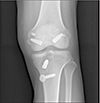1. Kennedy JC. Complete dislocation of the knee joint. J Bone Joint Surg Am. 1963; 45:889–904.


2. Robertson A, Nutton RW, Keating JF. Dislocation of the knee. J Bone Joint Surg Br. 2006; 88:706–711.


3. Reckling FW, Peltier LF. Acute knee dislocations and their complications. 1969. Clin Orthop Relat Res. 2004; (422):135–141.
4. Quinlan AG, Sharrard WJ. Postero-lateral dislocation of the knee with capsular interposition. J Bone Joint Surg Br. 1958; 40-B:660–663.


5. Bistolfi A, Massazza G, Rosso F, et al. Non-reducible knee dislocation with interposition of the vastus medialis muscle. J Orthop Traumatol. 2011; 12:115–118.

6. Durakbaşa MO, Ulkü K, Ermiş MN. Irreducible open posterolateral knee dislocation due to medial meniscus interposition. Acta Orthop Traumatol Turc. 2011; 45:382–386.

7. Harb A, Lincoln D, Michaelson J. The MR dimple sign in irreducible posterolateral knee dislocations. Skeletal Radiol. 2009; 38:1111–1114.

8. Jeevannavar SS, Shettar CM. ‘Pucker sign’ an indicator of irreducible knee dislocation. BMJ Case Rep. 2013; 2013:bcr2013201279.

9. Kilicoglu O, Akman S, Demirhan M, Berkman M. Muscular buttonholing: an unusual cause of irreducible knee dislocation. Arthroscopy. 2001; 17:E22.
10. Tateda S, Takahashi A, Aizawa T, Umehara J. Closed reduction of “irreducible” posterolateral knee dislocation - a case report. J Orthop Case Rep. 2016; 6:20–23.











 PDF
PDF ePub
ePub Citation
Citation Print
Print




 XML Download
XML Download